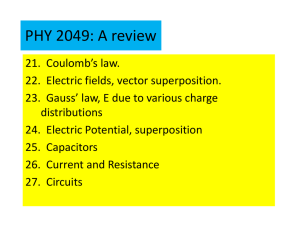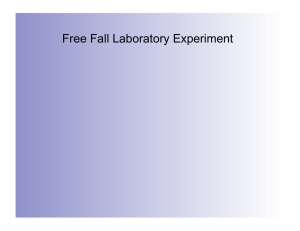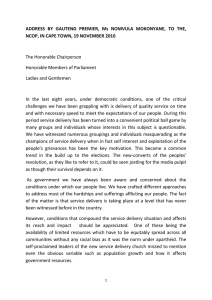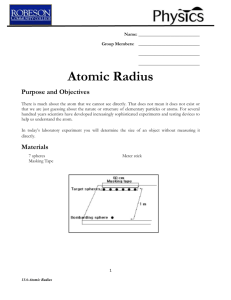16/04/2014 Background Culture Lab
advertisement
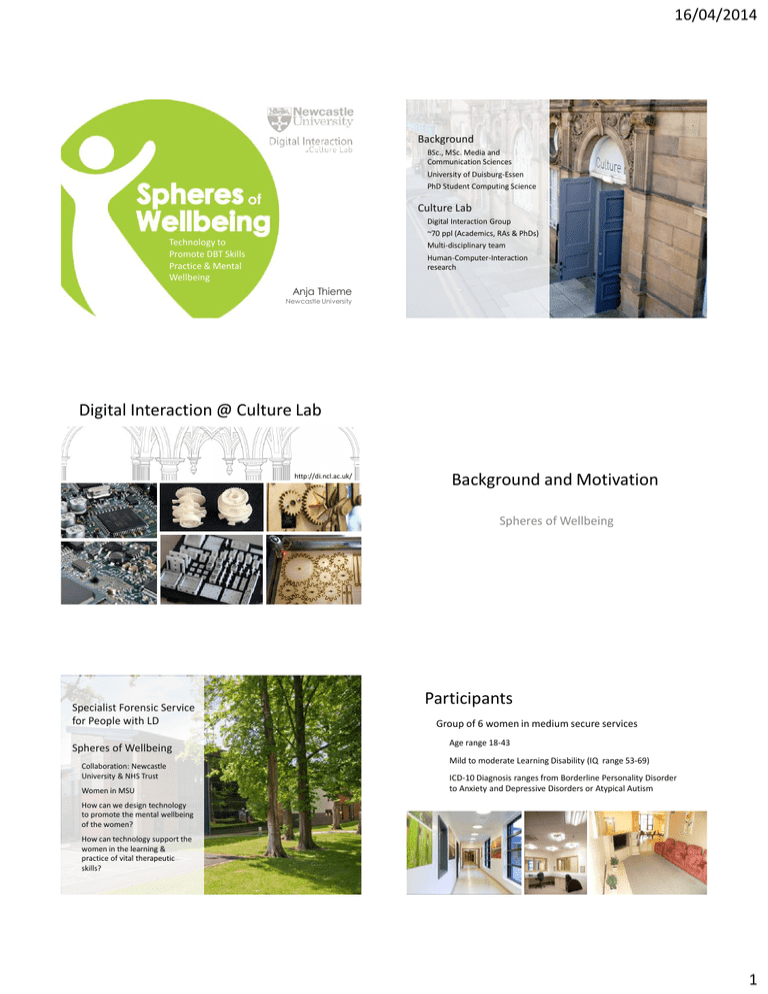
16/04/2014 Background BSc., MSc. Media and Communication Sciences University of Duisburg-Essen PhD Student Computing Science Culture Lab Digital Interaction Group ~70 ppl (Academics, RAs & PhDs) Multi-disciplinary team Technology to Promote DBT Skills Practice & Mental Wellbeing Human-Computer-Interaction research Anja Thieme Newcastle University Digital Interaction @ Culture Lab http://di.ncl.ac.uk/ Background and Motivation Spheres of Wellbeing Specialist Forensic Service for People with LD Spheres of Wellbeing Collaboration: Newcastle University & NHS Trust Women in MSU Participants Group of 6 women in medium secure services Age range 18-43 Mild to moderate Learning Disability (IQ range 53-69) ICD-10 Diagnosis ranges from Borderline Personality Disorder to Anxiety and Depressive Disorders or Atypical Autism How can we design technology to promote the mental wellbeing of the women? How can technology support the women in the learning & practice of vital therapeutic skills? 1 16/04/2014 Borderline Personality Disorder Approach: Collaboration with Staff Characteristics Emotion regulation difficulties Impulsivity and self-harm Cognitive disturbances (‘emptiness of self’) Interpersonal difficulties Person-focused design approach Close collaboration with hospital staff Mutual visits to hospital & Culture Lab Care Pathway Person-Centred Care Dialectical Behavioural Therapy (newly introduced) Challenges & Opportunities for Design Treatment & wellbeing needs Fit within hospital practices (person-centred care) DBT agenda: mindfulness, distress tolerance & sense of self Self-harm, impulsivity or aggression Safety of technology & research materials Learning Disability Accessiblity: avoid heavy text, make use of physical forms, be stimulating, visual or versatile Challenges & Opportunities for Design More personal/ human technology design Less technical/ medical intervention; not just a digital translation of therapy contents Addressing ‘engagement’ challenge Secure hospital services Personal possessions mostly prohibited Objects can act as extension of self (design for more personal technology relationship) Spheres of Wellbeing Technology Design Concept Spheres of Wellbeing 2 16/04/2014 Mindfulness Sphere Mindfulness Sphere Allows for careful observation of heartbeat moment by moment Envisioned to cultivate a new, experiential way of bringing awareness to this bodily sensation Provides biofeedback: self-regulation Calming Sphere Identity Sphere Small, purse-like artefact Bead bracelet (non-digital) Technology safely encased at the inside Concept of worry beads Screen visible at the inside Something physically to hold on to Symbol of safety & calm Use for mindfulness exercises, to practice self-control or relaxation 3 16/04/2014 Identity Sphere - videos Co-created with each woman Reflect positive, meaningful experiences & interests of the person Allow connection to positive aspects of their self + be reminiscent of things that are meaningful in their lives reassuring internal validation of self Camera scans environment for QR codes (at centre 0f Mandala pattern) Enable to perform to, and construct their identity through, others Triggers short videos Creative Activities Spheres of Wellbeing Creative Sessions Enjoyment Kim: “I really look forward to this session.” Lucy: “We are having fun, aren't we." Remarkable commitment 2-3 hour sessions, few breaks Hands’ on, tactile, creative & versatile, person-focused (1 on 1 sessions) “Me time” away from the flat and the other women Creative Sessions Women impressed with own creations & individual designs Sense of achievement & selfpride Staff-38: “(…) and I think just they were just proud of themselves I think that it's kind of, 'cause they are really lovely objects, I think they are just proud of themselves that they'd been able to achieve that and in that time, just for themselves to be able to commit to it." 4 16/04/2014 Creative Sessions Making own choices, personal responsibility Staff-09: "(…) 'cause I think they got a lot out of the interaction of creating it, creating something new, something individual and you know, the actual being part of it and sort of, kinda being left with, you know, as like 'Right, this is yours, this is what you've got to do - but you do it' you know, (…) it's totally their responsibility and I think they really enjoyed that…” Self-confidence & personally meaningful engagements Creative Sessions Positive interactions with staff (during & after sessions) Playful, positive, more balanced inter-personal communication (banter & laughter) Recognition & acknowledgement of achievements Alex: "It makes you feel good inside, 'cause I'm doing something for myself." Lessons Learned Very different to other ward activities Planning & more positive risk taking? Focus on abilities, interest & achievements Very enjoyable to staff But: Compromising safety protocols Deployment & Evaluation Methods Interviews: Deployment & Evaluation Spheres of Wellbeing 6 women (week 1 & 4) 17 staff (week 4) Recoded staff observations Event cards & diaries Log data of digital Spheres (week 1 to 15) 5 16/04/2014 Spheres Perception Spheres Perception Precious personal possessions Looking after the artefacts Sense of ownership Being protective of them Sally about her Mindfulness Sphere: “I love it. It's mine. I really do.“ When asked if she would give it away, she responds: “Even if my mum would try to have them, I wouldn’t let her take it." “Show & Tell” about the Spheres Self-pride & recognition by staff and peers Staff- 26: “(…) Kim for example, she seemed really, really proud of it, which is a really good thing, because it's, you know, possible she might not have a lot of things that she is proud of, but you could just see she was sort of brimming with pride, showing me the Sphere of Wellbeing, and showing me her pictures and stuff, she loved it (…)." Belongingness to Family Show & Tell + Giving bracelets away Kim: "I gonna look after this, I gonna keep it all in this box.“ Alex: [almost dropping her ball] “Ah, I can't break that, bloody hell, it means a lot to me." “Show & Tell” to Staff Sharing expertise about the Spheres Women: Self-confidence Staff: Get to know interests of women Staff-48: [about Janet] “She has talked to me about making it, when she's doing the game, talking me, she had to talk me through the game, she knows more than me (…)” Belongingness to Family Positive interactions with family S-46 about Sally (eventcard): Alex: “I used it on my visit yesterday, at my mums. Showed my mum what it is and then when my sister seen the other one 'Alex can I have it, it looks really nice' I went 'Alright, then have it'. When asked what her mum thought about the bracelet, Alex: "She loves the bracelet, she won't take it off. She won't take it off. (...) It was her birthday on Saturday anyway, so I thought I've given it to her for her birthday." “Sally said she wanted to get her ball out, sat at the dining room table - watched the colours change - then said was going to get her music wallet - started to listen to [music artist] at this point Sally said she wanted to phone her Nan. Sally phones her Nan and played the music ‘[artist] -family' [video] down the phone to her nan. Sally then went on to tell her Nan about the music and that song reminded her of her nan” 6 16/04/2014 Objects of comfort Feeling connected, Self-confidence Staff-44: [about Janet] “(…) she said she liked to look at it [the purse], it made her feel happy, made her feel that she wasn't on her own (…) with the ball she also said she was, she would sit in her room and feel close to something." Alex : "On my mum one, it makes me feel more confident like that I want to get out of here. I look at my mum. I think, I think that I should have more confidence in myself." Coping with Distress Staff expectations and disappointments Staff-07: “(...) Erm, I've tried to, if people have been in a bad place to offer access to, to the objects as one of the strategies, but it hasn't always been well received. Sally has often said 'no' and Lucy once threw the purse at me [laughs], but, she didn't want to use it, but, yeah... " Challenges & Complexities Inter-individual differences in… Relaxation & Calm Sally: [about her MSphere] “It sends me to sleep a lot. I like the lights. It reminds me when I was little, and the lights you can get.“ Staff-38: “Alex, she said she'd gone in her room just to watch the ball change colours and she'd watched her heart rate and stuff, she'd actually say she'd been a bit stressed and she'd used it to calm her down, but I think she, 'cause she wasn't stressed when she went into her room, I think she was just feeling a bit lonely, a bit low I think. I think she did use it, but I think, she said she looked up at the lights, I think it did calm her down. “ Self-Distraction Staff-22 (eventcard): “Zoe was prompted to use her objects after feeling low - was being nursed on level 3 supervision in her bedroom. Zoe listen to her music app watched the ball change colours in the dark. Zoe settled returned back to communal lounge started to interact with peers and staff.” Staff-48: [about Janet] "I think it takes her mind, occupies her mind, makes her focus on other things rather than what was upsetting her in the first place, I think it takes her mind away and she gets, it helps her focus on something else.“ Challenges & Complexities Difficult ward environment …motivation & interests Staff dynamics …cognitive abilities & understanding of DBT External research project vs. integration in hospital services & ‘champion’ in place …risk behaviours & access … changing mental health 7 16/04/2014 Summary & Implications Summary & Implications Collaboration with hospital staff Uses of the Spheres for Mental Health & Wellbeing Fundamental in the design and evalution process: understanding the complex condition of the women, their therapy, secure services & ethics Acts of Show & Tell Recognition of Achievements: Nurturing Self-Pride & Self-Worth Spheres created opportunities for positive, balanced communication with staff Spheres design reflect a series of trade-offs (challenging context) Importance of ‘Belongingness’ to Staff, Peers & Family Coping with distress vs. managing wellbeing Co-creation process with the women Independence (miracle tool) vs. Interdependence (need for personal support) Carefully scaffolded, person-focused Enjoyable and worth-while in its own right Potential for mindfulness and more DBT focused activities not yet fully explored More personal relationship with Spheres Thank you! References Clayton, P. From insecure attachment to (partial) inter-subjectivity (fearful aloneness to safely being with others). Journal of Learning Disability and Offending Behaviour 1, 1 (2010), 33-43. Christensen, K., Riddoch, G., and Eggers Huber, J. Dialectical Behavior Therapy Skills, 101 Mindfulness exercises and other fun activities for children and adolescents. A learning supplement. AuthorHouse, 2009. Durbin, L.S. The history of beads: From 100,000 B.C. to the present. ABRAMS, 2009. Galvin, M. (2011). How do people perform their identity in the way in which they personalise their space? Diploma thesis in Psychology, University College Cork, Ireland. Lew M., Matta C., Tripp-Tebo C., and Watts D. DBT for individuals with intellectual disabilities: a programme description. Mental Health Aspects of Developmental Disabilities 9 (2006), 1-12. Linehan, M.M. Cognitive-behavioral treatment for borderline personality disorders. New York, Guilford, 1993. Linehan, M.M.. Skills Training Manual for Treating Borderline Personality Disorder. New York, Guilford, 1993. Lönnebo, M., Welin, C., and Johansson, C. Pearls of Life: for the personal spiritual journey. Wild Goose Publications, 2007. Palmer, R.KL. Dialectic behaviour therapy for borderline personality disorder. Advances in Psychiatric Treatment 8 (2002), 10-16. Robertson, B. The adaption and application of mindfulness-based psychotherapeutic practices for individuals with intellectual disabilities. Advances in Mental Health and Intellectual Disabilities 5, 5 (2011), 46-52. Contact Anja Thieme PhD Student Culture Lab Newcastle University anja.thieme@ncl.ac.uk +44 0191-2464637 Funded by References Sakdalan, J.A., Shaw, J., and Collier, V. Staying in the here-and-now: A pilot study on the use of dialectical behaviour therapy group skills training for forensic clients with intellectual disability. Journal of Intellectual Disability Research 54, 6 (2010), 568-572. Soler, J., et al. Dialectical behaviour therapy skills training compared to standard group therapy in borderline personality disorder: A 3-month randomised controlled clinical trial. Behaviour Research and Therapy 47 (2009), 353-358. Swenson, C.R. How can we account for DBT’s widespread popularity? Clinical Psychology: Science and Practice 7 (2000), 87-91. Thieme, A., Wallace, J., Johnson, P., McCarthy, J., Lindley, S., Wright, P., Olivier, P., & Meyer, T.D. (2013). Design to promote mindfulness practice and sense of self for vulnerable women in secure hospital services. In Proc. CHI 2013, 2647-2656. Thieme, A., Wallace, J., Thomas, J. T., Chen, K.L., Krämer, N., & Olivier, P. Lover's box: Designing for reflection within romantic relationships. International Journal of Human Computer Studies, 69(5), 2011, 283-297. Verheul, R., et al. Dialectical behaviour therapy for women with borderline personality disorder: 12month, randomised clinical trial in the Netherlands. British Journal of Psychiatry 182(2003), 135-140. Wallace, J., Thieme, A., Wood, G., Schofield, G., and Olivier, P. Enabling self, intimacy and a sense of home in dementia: An enquiry into design in a hospital setting. In Proc. CHI 2012, 2692-2638. Williams, M., Teasdale, J., Segal, Z., & Kabat-Zinn, J. The mindfulness way through depression. Guilford Press, 2007. Yen, S., Zlotnick, C., and Costello, E. Affect regulation in women with borderline personality disorder traits. The Journal of Nervous and Mental Disease 100, 10 (2002), 693-696. Statistics Amount of interaction events with Identity and Mindfulness Spheres across the first 15 weeks of the deployment Identity Sphere (n = 5) Mindfulness Sphere (n = 6) 50 45 40 35 30 25 20 15 10 5 0 Week 1 Week 2 Week 3 Week 4 Week 5 Week 6 Week 7 Week 8 Week 9 Week 10 Week 11 Week 12 Week 13 Week 14 Week 15 8 16/04/2014 Statistics Statistics Amount of events and their duration (in sec) Amount of videos Overall amount and types of videos triggered by each woman N mean SD median min max triggered per event (MD) triggered overall played partially played fully Zoe 9 423.4 256.1 348 193 1021 3 (max = 8) 37 37 9 45 Janet 15 377.9 336.6 255 35 1374 2 (max = 4) 29 29 24 40 Lucy 19 1084 1005 600 178 3490 1 (max = 6) 44 44 49 Kim 20 510 509 393 25 1770 2.5 (max = 19) 70 69 25 Sally 34 524.9 397.8 439.5 58 1764 3 (max = 14) 119 115 74 35 30 25 20 15 10 Continuous heartbeat signals 6 356 453 11 22 1064 14 4 477 1 49 16 255 5 233 285 33 14 582 2 19.5 4 275 Kim 9 254 225 267 30 633 2 37 4 389 Sally 16 221 229 140 21 717 1.5 30 4 268 Alex 21 165 192 94 20 810 1 38 5 614 Lucy 0 Lucy Janet Zoe Kim Football Janet 5 2 Family 1661 Animation 17 Music 174 Animation 531 max Family 406 min Music 10 Average (MD) Music & Cats Zoe No. of signals per event (MD) Animation Max Animation min Family median Comp. Games SD Music mean Music N No. heartbeats per signal Football Amount of events and their duration (in sec) Sally 9
